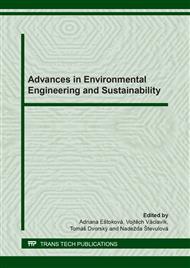[1]
F. Asdrubali, F. D´Alessandro, S. Schiavoni, A review of unconventional sustainable building insulation materials, Sustain. Mater. Technol. 4 (2015) 1-17.
Google Scholar
[2]
C. Ingrao, J. Bacenetti, A. Bezame, V. Blok, J. Geldermann, P. Goglio, E.G. Koukios, M. Lindner, T. Nemecek, V. Siracusa, A. Zabaniotou, D. Huisingh, Agricultural and forest biomass for food, materials and energy: bio-economy as the cornerstone to cleaner production and more sustainable consumption patterns for accelerating the transition towards equitable, sustainable, post fossil-carbon societies, J. Clean. Prod. 117 (2016) 4-6.
DOI: 10.1016/j.jclepro.2015.12.066
Google Scholar
[3]
C. Ingrao, A. Lo Guidice, J. Bacenetti, C. Tricase, G. Dotelli, M. Fiala, V. Siracusa, C. Mbohwa, Energy and environmental assessment of industrial hemp for building applications: a review, Renew. Sust. Energ. Rev. 51 (2015) 29-42.
DOI: 10.1016/j.rser.2015.06.002
Google Scholar
[4]
F. Pacheco-Torgal, S. Jalali, Cementitious building materials reinforced with vegetable fibres: a review, Construct. Build. Mater. 25 (2011) 575-591.
DOI: 10.1016/j.conbuildmat.2010.07.024
Google Scholar
[5]
M. Jawaid, P. Md Tahir, N. Saba, Lignocellulosic fibre and biomass-based composite materials, 1st ed., Woodhead Publishing, (2017).
Google Scholar
[6]
M. Bentchikou, A. Guidoum, K. Scrivener, K. Silhadi, S. Hanini, Effect of recycled cellulose fibres on the properties of lightweight cement composite matrix, Construct. Build. Mater. 34 (2012) 451-456.
DOI: 10.1016/j.conbuildmat.2012.02.097
Google Scholar
[7]
A. Célino, S. Fréour, F. Jacquemin, P. Casari, The hygroscopic behavior of plant fibers: A review, Front. Chem. 1 (2013), Article 43.
DOI: 10.3389/fchem.2013.00043
Google Scholar
[8]
J.Y. Chen, L. Sun, I.I. Negulescu, B. Xu, Fabrication and evaluation of regenerated cellulose/nanoparticle fibers from lignocellulosic biomass, Biomass Bioenerg. 101 (2017) 1-8.
DOI: 10.1016/j.biombioe.2017.03.024
Google Scholar
[9]
R. Dungani, H.P.S. Abdul Khalil, I. Sumardi, Y. Suhaya, E. Sulistiawati, M.N. Islam, N.L.M. Suraya, S. Aprilia, Non-wood renewable materials: Properties improvement and its application, in: K. Hakeem, M. Jawaid, M., U. Rashid (Eds.), Biomass Bioenerg. (2014), .1-29.
DOI: 10.1007/978-3-319-07578-5_1
Google Scholar
[10]
A. Ashori, T. Tabarsa, I. Valizadeh, Fiber reinforced cement boards made from recycled newsprint paper, Mater. Sci. Eng. A - Struct. 528 (2011) 7801-7804.
DOI: 10.1016/j.msea.2011.07.005
Google Scholar
[11]
Z. Wang, H. Li, Z. Jiang, Q. Chen, Effect of waste paper fiber on properties of cement-based mortar and relative mechanism, Journal of Wuhan University of Technology - Mater. Sci. Ed. (2018) 419-426.
DOI: 10.1007/s11595-018-1839-2
Google Scholar
[12]
L. Gil, E. Berant-Masó, F.J. Caňavate, Changes in properties of cement and lime mortars when incorporating fibers from end-of-life tires, Fibers 4 (2016) 7.
DOI: 10.3390/fib4010007
Google Scholar
[13]
N. Stevulova, V. Hospodarova, A. Estokova, E. Singovszka, M. Holub, S. Demcak, J. Briancin, A. Geffert, F. Kacik, V. Vaclavik, T. Dvorsky, Characterization of manmade and recycled cellulosic fibers for their application in building materials, accepted to J. Renew. Mater. (2019).
DOI: 10.32604/jrm.2019.07556
Google Scholar
[14]
V. Hospodarova, N. Stevulova, J. Briancin, Investigation of waste paper cellulosic fibers utilization into cement based building materials, Buildings 8 (2018) 43.
DOI: 10.3390/buildings8030043
Google Scholar
[15]
STN 72 1217, Limestone, dolomite. Quality. Bratislava (Slovakia): Office of Standards, Metrology and Testing, (1992).
Google Scholar
[16]
STN EN 196-1, Methods of testing cement. Part 1: Determination of strength. Bratislava (Slovakia): Office of Standards, Metrology and Testing, (2016).
Google Scholar
[17]
STN EN 197-1, Cement. Part 1: Composition, specifications and conformity criteria for common cements. Bratislava (Slovakia): Office of Standards, Metrology and Testing, (2012).
Google Scholar
[18]
STN EN 1008, Mixing water concrete. Specification for sampling, testing and assessing the suitability of water, including water recovered from processes in the concrete industry, as mixing water for concrete. Bratislava (Slovakia): Office of Standards, Metrology and Testing, (2003).
DOI: 10.3403/02609198
Google Scholar
[19]
STN EN 1015-3, Methods of test for mortar for masonry. Part 3: Determination of consistence of fresh mortar (by flow table). Bratislava (Slovakia): Office of Standards, Metrology and Testing, (2000).
DOI: 10.3403/01541440
Google Scholar
[20]
STN EN 1015-11/A1, Methods of test for mortar for masonry. Part 11: Determination of flexural and compressive strength of hardened mortar. Bratislava (Slovakia): Office of Standards, Metrology and Testing, (2007).
DOI: 10.3403/01905442u
Google Scholar
[21]
STN EN 1015-12, Methods of test for mortar for masonry - Part 12: Determination of adhesive strength of hardened rendering and plastering mortars on substrates. Bratislava (Slovakia): Office of Standards, Metrology and Testing, (2016).
DOI: 10.3403/02027531u
Google Scholar
[22]
L. Svoboda et al., Building Materials, 4th ed., Prague, (2018).
Google Scholar


